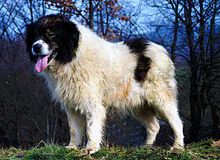Tornjak

Tornjak
|
||||||||||||||||||
| Other names | Bosnian and Herzegovinian Shepherd Dog Bosnian Shepherd Dog Croatian Mountain Dog Bosnian-Herzegovinian and Croatian Shepherd Dog (FCI) |
|||||||||||||||||
|---|---|---|---|---|---|---|---|---|---|---|---|---|---|---|---|---|---|---|
| Origin |
Bosnia and Herzegovina Croatia |
|||||||||||||||||
|
||||||||||||||||||
| Notes | Breed provisionally accepted, not eligible for the CACIB | |||||||||||||||||
| Domestic dog (Canis lupus familiaris) | ||||||||||||||||||
| Classification / standards | |||
|---|---|---|---|
| FCI | Group 2, Section 2.2 Molossian: Mountain type #355 (provisional) | standard | |
| AKC | |||
| The AKC Foundation Stock Service (FSS) is an optional recording service for purebred dogs that are not yet eligible for AKC registration. | |||
| UKC | Guardian Dog | standard | |
The Tornjak (pronunciation is "tornyak") is a mountain native to Bosnia and Herzegovina and Croatia. FCI #355 as Bosnian-Herzegovinian and Croatian Shepherd Dog (official English name) or Tornjak (official original name).>
Tornjaks are large and powerful dogs, with well proportioned, almost square-bodied features and agile movements. The dog's bones are not light, but nevertheless not heavy nor coarse. They have a long and thick double coat with a thick undercoat. The bodies of these dogs are strong and well built, with harmonious and dignified movements. The dogs have long and thick hair and this adequately protects them against poor weather conditions. The dogs typically possess shaggy tails, kept high like a flag. Tornjaks have a clear, self-confident, serious and calm disposition. In general the Tornjak is a long-coated dog with short hair over the face and legs. The topcoat is long, thick, coarse and straight. It is especially long on the upper part of the croup; over the shoulders and the back it can be slightly wavy. On the muzzle and the forehead, up to the imaginary line connecting the ears, over the ears. On the front parts of the legs and feet it is short. It is especially abundant around the neck (mane), dense and long over the upper thighs (breeches). It forms feathers along the forearms. With well-coated dogs it is also especially abundant on the rear of hind pasterns.
Tornjaks can be either solid colored or parti-colored, usually the color white predominates. The color of Tornjaks is unrestricted, all colors are accepted. It ranges from nearly completely white to almost black with yellow, red, brown and not-quite-desired gray in between. There are two main types: piebald and Irish spotting. Originally, the goal was to breed varying colors and patterns so shepherds could distinguish their dogs easily from a distance. Breeders also strive towards distinction compared to other breeds.
Tornjak has a calm temperament. A typical adult Tornjak is very calm, peaceful, at first sight an indifferent animal, but when the situation demands it, it is a vigilant and very alert watchdog. The character is equal to the temperament; they are not nervous nor aggressive. In general, they are very tough, not too demanding, sturdy dogs. With their human family they are very emotional. When living in a pack they are highly social animals and there isn't any fighting between the pack members. Towards strangers or other animals, as a rule, Tornjak is not overly aggressive. But when the situation calls upon it, Tornjak is quite decisive and it can without any consideration attack even much stronger rivals. Shepherds used to say that a Tornjak who guards the flock is a fair match to two wolves, and a couple will confront and chase away a bear without any undue respect. In these situations Tornjaks are very tenacious.
...
Wikipedia
